
Written By: Gloria Tsang, RD
Title: Founding Registered Dietitian
Alumni: University of British Columbia
Last Updated on:

Halloween is the one night of the year when all kids (young and old) are focused on candy. We all know it’s not health food, but the truth is that not all candies are created equal – even if they look and taste similar. So how do you know which candies will cause the least damage to the ghouls and goblins in your neighborhood this Halloween?
With big differences in calories, sugar, and quality of ingredients used, the fact is, choosing the right candy can reduce the health impact of your kid’s trick-or-treat haul. None of them are exactly good for you, of course, but we’ve done some close analysis of 20 popular Halloween candies to see which options are best from a nutrition perspective. All of our analysis was based on Halloween-sized (“fun-sized”) versions of the candy.

Table of Contents
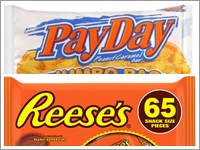 Based on the argument that peanut fans love real peanuts, PayDay is the clear winner here. Both bars have similar calories and sugar, but PayDay is the only candy we examined not to list sugar as the first ingredient. Instead, peanuts are found in the number-one spot. The Reese’s Cups also contain polyglycerol polyricinoleate (PGPR), a commercial emulsifier used to reduce the amount of cocoa butter required and reduce manufacturing costs.
Based on the argument that peanut fans love real peanuts, PayDay is the clear winner here. Both bars have similar calories and sugar, but PayDay is the only candy we examined not to list sugar as the first ingredient. Instead, peanuts are found in the number-one spot. The Reese’s Cups also contain polyglycerol polyricinoleate (PGPR), a commercial emulsifier used to reduce the amount of cocoa butter required and reduce manufacturing costs.
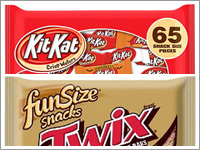 They’re similar in calories and sugar (and both include PGPR), but Twix’s ingredient list is surprisingly long. Even more surprising? Twix is marketed as a biscuit topped with caramel and chocolate, but there’s no caramel on the ingredient list. Instead, the caramel is likely made from solid oil with flavorings.
They’re similar in calories and sugar (and both include PGPR), but Twix’s ingredient list is surprisingly long. Even more surprising? Twix is marketed as a biscuit topped with caramel and chocolate, but there’s no caramel on the ingredient list. Instead, the caramel is likely made from solid oil with flavorings.
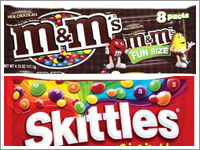 Both of these shiny mini-candies contain artificial colorings, wax, and a super-long list of ingredients. Hello, Yellow 5 and Red 40! M&Ms at least offer a tiny amount of calcium and protein instead of a sugar rush – they have about 10% less sugar than Skittles.
Both of these shiny mini-candies contain artificial colorings, wax, and a super-long list of ingredients. Hello, Yellow 5 and Red 40! M&Ms at least offer a tiny amount of calcium and protein instead of a sugar rush – they have about 10% less sugar than Skittles.
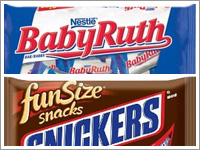 Unfortunately, there’s no real winner here – we found partially hydrogenated oil on Snickers’ ingredient list, while Baby Ruth has high-fructose corn syrup and the preservative TBHQ. In this case, Snickers loses out simply because the portion is larger, leaving room for 50% more calories.
Unfortunately, there’s no real winner here – we found partially hydrogenated oil on Snickers’ ingredient list, while Baby Ruth has high-fructose corn syrup and the preservative TBHQ. In this case, Snickers loses out simply because the portion is larger, leaving room for 50% more calories.
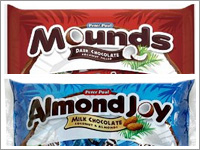 Mounds uses semi-sweet instead of milk chocolate, which means the chocolate has a higher concentration of cocoa solids and less sugar. Mounds also has a shorter ingredient list, and skips the partially hydrogenated oil found in Almond Joy.
Mounds uses semi-sweet instead of milk chocolate, which means the chocolate has a higher concentration of cocoa solids and less sugar. Mounds also has a shorter ingredient list, and skips the partially hydrogenated oil found in Almond Joy.
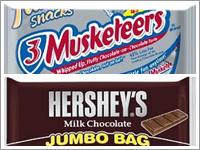 For those looking for a straight chocolate taste, these choices offer similar calories. 3 Musketeers wins partly because it skips the sneaky PGPR found in the Hershey’s bar. But its main winning feature is that it was unique among the candies we surveyed in actually including real cocoa powder – a great item to see on the ingredient list.
For those looking for a straight chocolate taste, these choices offer similar calories. 3 Musketeers wins partly because it skips the sneaky PGPR found in the Hershey’s bar. But its main winning feature is that it was unique among the candies we surveyed in actually including real cocoa powder – a great item to see on the ingredient list.
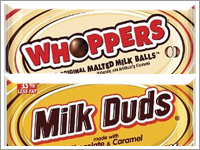 Whoppers are crunchy, while Milk Duds are incredibly chewy and will stick to your (or your kid’s) teeth, so they’re a no-no for anyone with dental issues. Plus, the Whoppers serving is significantly smaller (6.83 g compared to 12 g for Milk Duds), which saves about 22 calories.
Whoppers are crunchy, while Milk Duds are incredibly chewy and will stick to your (or your kid’s) teeth, so they’re a no-no for anyone with dental issues. Plus, the Whoppers serving is significantly smaller (6.83 g compared to 12 g for Milk Duds), which saves about 22 calories.
Of course, no matter which Halloween candies you give out, you can’t control what comes home in your child’s trick-or-treat bag. Regardless of which treats they bring home, limit them to eating two or three small treats at a time so they can enjoy their haul without gorging themselves (or even making themselves sick).
Alumni: University of British Columbia – Gloria Tsang is the author of 6 books and the founder of HealthCastle.com, the largest online nutrition network run by registered dietitians. Her work has appeared in major national publications, and she is a regularly featured nutrition expert for media outlets across the country. The Huffington Post named her one of its Top 20 Nutrition Experts on Twitter. Gloria’s articles have appeared on various media such as Reuters, NBC & ABC affiliates, The Chicago Sun-Times, Reader’s Digest Canada, iVillage and USA Today.
candy, chocolate, grocery aisle, halloween, kid's nutrition, seasonal celebrations